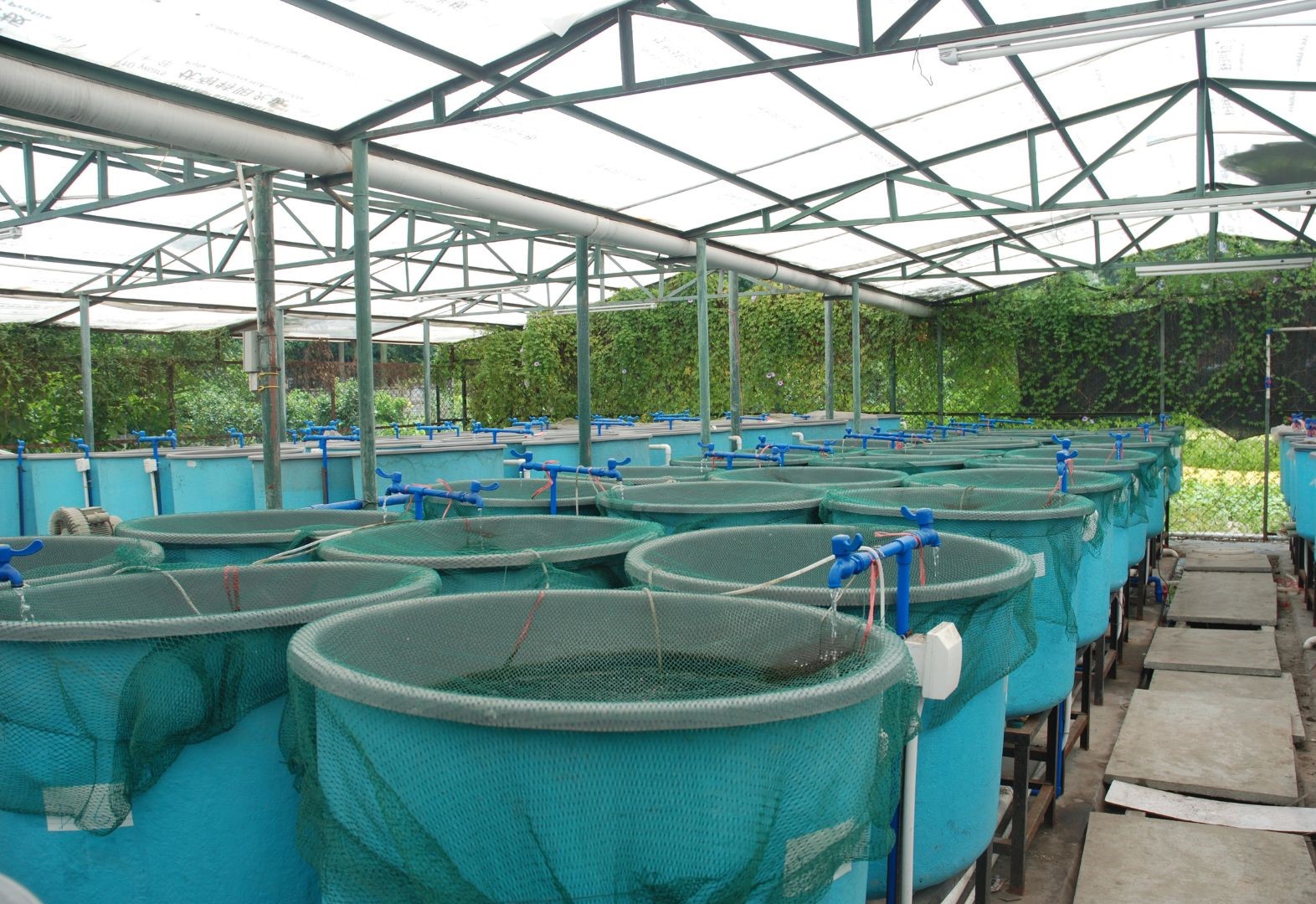Innovative Climate-Smart Aquaculture Systems for Sustainable Fish Farming
- Introduction
Aquaculture has advanced with more innovative cultivation methods, from the traditional earthen ponds and cage systems in water bodies to more improved climate-smart, efficient, and cost-effective methods for small and medium-scale fish farmers. Global fish production will continue to increase to meet growing demand, reaching 202 million tons by 2032, but at a slower rate than over the past decade. This slowing growth reflects the impact of policy changes in China, which have slowed manufacturing expansion, increased input costs, especially energy, and the assumption that 2032 will be an El Niño caused production to decline, mainly in South America. Most of the additional output will be generated by the aquaculture industry.
By 2032, aquaculture production is expected to account for 55% of total fish production, compared with 50% in the base period. On average, the fishery will provide about 92 Mt of fish per year, with lower levels during El Niño. In 2022, aquaculture overtook fishing as the main fish production sector for the first time in history. Global aquaculture output reached a record high of 130.9 million tons, of which 94.4 million tons were seafood, accounting for 51% of total seafood production.
Climate Smart Aquaculture Systems.
1. Tanks
Earthen, polyethylene, galvanized steel, fiberglass, and concrete tanks can be placed along a river or stream or on any land surface for aquaculture. Domestic or household aquaculture systems use tanks for fish farming due to their portability even in a limited space. Easily accessible Biomaterials are used in the construction of tanks because they do not quickly become contaminated with poison or other toxic materials. Tanks come in various shapes and sizes and are easy and relatively cheap to maintain. Tanks are closed aquaculture systems and are, therefore, like ponds in their operation and can be operated indoors or outdoors. The difference between ponds and tanks is that tanks are constructed above ground but can be made to ‘interact’ with soil at the bottom. Often used for research and training purposes, conditions in the tanks can be controlled, and activities such as fertilization, supplementary feeding, and stocking are essential. The harvesting of fish is easy in these aquaculture systems.
2. Pond culture
Pond farming is the most popular form of aquaculture and has evolved with modifications over the period, which makes it more appropriate for large-scale aquaculture farming. It can be divided into still and running water ponds, which are more suitable for upland areas with good domestic water supply. Ponds come in a variety of shapes, from simple earthen ponds to reinforced ponds (cement, plastic), and can be raised (watershed) or dug into the flat ground (excavated) or taken from lakes, reservoirs with raised walls (dyke) (Whitis, 2002; Egna and Boyd, 1997). The pond can be designed to be supplied with water from rain (sky pond) and/or have an inlet and outlet system for controlled water circulation. Water can come from streams, canals, or underground sources such as wells. The water holding capacity of a pond depends on the soil composition of the pond bottom and the underground water level. The sandier the soil, the less water it can hold in the pond system to improve production; pond aquaculture systems may require liming (to balance water pH), fertilization and/or fertilizer (depending on pond soil and water quality), and fish stocking breed, feed fish regularly and harvest fish at the right time. Most aquaculture training and capacity building currently relies on pond farming because it is a simple and profitable form of production. This is suitable for many purposes, from domestic to commercial, small to medium, and large scale (intensive), with appropriately applied pond design, storage, and feeding mechanisms. In some rare cases, such as large aquaculture enterprises, fish farming is carried out, while small donor-funded operations rely on external sources to raise fish. This answers the question of the sustainability of aquaculture for local farmers, as it is important to ensure good quality fingerlings (fry) for successful fish production.
3. Pen and cage culture
The basic procedures for managing cage and pen culture are similar to pond and cage culture. They involve the construction and preparation of growing facilities for storage, propagation, and harvesting, although there may be some variations. However, pens and cages that can float or sink in flowing water (rivers, streams, estuaries, seas) or stagnant water (lakes, reservoirs, large ponds) are open systems and are less controlled than ponds and tanks. Therefore, fertilizing, liming, and using pesticides is impossible. The advantage of cage culture over enclosure culture may be due to its greater flexibility in terms of structural placement. Productivity from pen and cage culture is generally high, with or without supplementary feeding, depending on the natural productivity of the water body. Disadvantages of farming in pens/cages include difficulty handling when water is disturbed, high dependence on artificial nutrition, and the need for high-quality food in proteins, vitamins, and minerals. High levels of food loss were recorded due to open cage walls, which also meant interference with natural fish populations around the pen/cage; and finally, the risk of theft is very high. Although small, these projects have been successful as commercial ventures, and with increased capital, cage farming can be expanded in the region due to the many reservoirs in the area.
4. Recirculation aquaculture systems
In Recirculation Aquaculture Systems (RAS), many high-quality fish can be grown using a small amount of water, which is reused, reused, or re-circulated. The water conservation and reuse aspect of RAS is important as a CSAq approach. In addition, a properly functioning recirculation system aerates the water, adding oxygen and, conversely, removing carbon dioxide, as well as the ammonia that fish excrete as a by-product of the catabolism of protein. This helps create good water quality conditions, which, in turn, boost production. However, the limitation to implementing the RAS system is the high costs involved in setting it up. A RAS can be run inside a greenhouse to ensure a warm water temperature throughout the growing cycle.
5. Aquaponics
Aquaponics is a combination of aquaculture and hydroponics (soilless cultivation of crops and vegetables), meaning growing fish and plants together in an integrated agricultural system. This integrated approach to farming has been used since time immemorial, especially by the Chinampas of Mexico and in integrated paddy systems across parts of Asia. It is currently highly acclaimed, mainly when used with renewable energy sources such as solar. Environmentally friendly organic waste is circulated and used to fertilize each component, thus producing minimal waste. The waste from the fishponds provides an organic food source for growing plants. The plants provide a natural filter for the water the fish live in. Like the integrated aquaculture system, aquaponics is a technology ideal for intensive commercial and non-commercial aquaculture setups with the advantages of efficiency in water usage and conservation (Gith, 2013; Bradley, 2014).
6. Integrated aquaculture system
Suppose sustainability is achieved, especially in predicted warming and drying conditions. In that case, food production systems must be integrated to allow sequential linkages between different agricultural activities to efficiently use scarce available resources (Little et al., 2003). Integrated aquaculture systems are a sustainable solution to environmental deprivation that manifests in various forms, such as land shortage, financial stress, and various socio-economic constraints. This involves the production of fish, crops, and other livestock in a coordinated framework, where one production benefits from the other (Land-Based Aquaculture Assessment Framework immediately, 2017). This system has been in practice for more than 1,500 years in countries such as India and China. Due to the scarcity of water resources, partly due to climate change and climate change, integrated aquaculture is becoming the best method to use resources efficiently. Integrated aquaculture is considered an alternative for efficient resource use, water recycling, and energy conservation. Another advantage of this method is the cost-effectiveness of using wastewater. On the other hand, integrated aquaculture not only has minimal impact on the environment but also increases productivity (Angel & Freeman, 2009). However, this approach requires good management to balance nutrient input and flow. Integrated aquaculture includes the simultaneous or sequential combination of two or more activities, at least one of which is fish farming. These benefits can occur directly on-site or indirectly through external needs and opportunities. The benefits of integration are synergistic rather than additive, and fish, crop, and livestock components may benefit to varying degrees. In an integrated system, fish, livestock, and crops are produced in a coordinated framework, with waste from one component serving as a resource for the other. Water from fishponds is rich in nutrients, so it is used to irrigate crops and complete the cycle.
Factors that influence farmers in adopting Climate Smart Aquaculture (CSAq) systems.
- Availability of household labor: It is economically expedient to utilize household labour in CSAq. When farmers decide on CSAq adoption, they will consider spending more labor on buying seeds, stocking, and harvesting than conventional practice.
- Access to information on CSAq practices: When farmers can easily access CSAq information from the aquaculture extension system, the probability of adopting a decision increases.
- The market price of products applying CSAq practices. Likewise, when farmers perceive that the market price of CSAq products is higher than the price of non-CSAq products, their adoption decision probability increases by 16.0%.
- Economic efficiency is the first factor considered in the farmers’ decision-making. This can then be related to aquaculture being an important household livelihood in NCC. When they perceive that the CSAq model could bring more revenues than normal, their adoption probability will increase. This entails that improving the economic efficiency of CSAq is crucial in expanding the farmers’ application
- Ability to ensure food security: When farmers see that CSAq ensures their daily meals and, eventually, food security for their households, the probability of adopting the decision increases to 10.3% on average.
- Improved pond environment when applying CSAq practices: Concerning pond environment improvement, when farmers perceive that this model helps reduce the amount of organic waste in the pond bed, decision probability increases.
Global regional aquaculture’s contribution
Global aquaculture’s contribution to fish production globally reached 46.0 percent in 2018, compared with 25.7 percent in 2000 and 29.7 percent in the rest of the world, excluding China, compared with 12.7 percent in 2000.
Global regional level percentage of fish produced from 2000 -2018
Region Aquaculture Contribution %
- Africa 17.9%
- Europe 17.0%
- The Americas 15.7%
- Oceania 12.7%
- Asia (excluding China) 42.0%
- Conclusion
Aquaculture has evolved significantly, moving beyond traditional methods like earthen ponds and cage systems. Instead, it now employs innovative, climate-smart approaches that are efficient and cost-effective for small and medium-scale fish farmers. By 2032, aquaculture is projected to account for 55% of total fish production, surpassing fishing as the primary sector. In 2022, global aquaculture output reached a record high of 130.9 million tons, contributing 51% of total seafood production. To sustain this growth, climate-smart systems such as pond culture, tanks, pens, recirculation aquatic systems, aquaponics, and integrated aquatic systems play a crucial role.
References
- FAO Report: Global fisheries and aquaculture production reaches a new record high https://www.fao.org/newsroom/detail/fao-report-global-fisheries-and-aquaculture-production-reaches-a-new-record-high.
- http://articles.extension.org/pages/58771/pond-culture.
- Bio floc fish farming https://www.nagodas.com/pond-traditional-culture.php.
- Fish farm on Wando Island, South Korea | South Korea, Fish farming, Korea https://kr.pinterest.com/pin/405535141418384500.
- https://www.milkwood. net/2014/01/20/aquaponics-a-brief-history.
- http://www.dw.com/en/sustainable-farming-project- combines-aquaculture-and-hydroponics/a-16927582.
- mekarn.org/workshops/environ/PDF/Lindberg.
- researchgate.net/publication/226829080_Integrated_Agri- Aquaculture_Systems.
- fao.org/fileadmin/templates/FCIT/ Meetings/World_Water_Day_2011/5.
- http://www.aquacare.com/products/fish-farming-tanks.
- http://www.farmB.com/aquaponics/aquaculture-tank.
Further reading
Certifications for Aquaculture products
Restorative Aquaculture: Principles for Sustainable Marine Ecosystems
Microbial additives used in aquaculture
Circular Food Innovations: Understanding the Concepts and Application to Aquaculture
Control Nile Tilapia Stocks in Polyculture system using African Sharptooth Catfish











































































